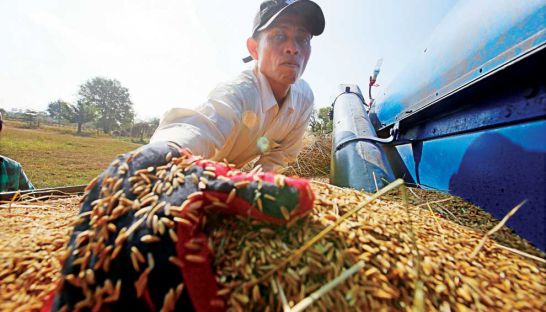Few takers for emergency rice loans
Few takers for emergency rice loans
With the Kingdom’s main rice harvesting season wrapping up, just a fraction of a government emergency loan package that aimed at giving millers the liquidity they needed to purchase rice paddy during the harvest cycle has been disbursed, leaving the government and private sector divided on why.

Kao Thach, chief executive of the Rural Development Bank (RDB), the government-owned bank that was entrusted last September with disbursing $27 million in low-interest loans to millers, said only five loans were issued due to a lack of demand. He said that despite rice millers claiming to be suffering financial difficulties, few seemed genuinely interested in obtaining the bank’s low-interest credit lines.
“We are looking at how to best use the loans to help Cambodian rice millers survive, but so far only 12 percent of the loans have been disbursed, which is not rational given millers’ claims of money shortages,” he said yesterday. “We don’t know what is really happening with their activity and why the borrowing has been so slow.”
The government made sure the loans were easy and convenient to access for millers, Thach said, requiring only rice paddy stock as collateral, while imposing a low annual interest rate of 7 percent. The criteria were much less complicated than those of banks or MFIs, he added.
“Our terms and conditions are convenient and we make sure to disburse the loans in only one or two days after checking rice stocks for collateral,” he said. “I suspect that the rice millers are not really facing money shortages.”
In June, the unused funds will be returned to the government, Thach said. It is unclear if a similar package will be approved again for the next harvest seasons starting in September, he noted.
Hun Lak, president of the Cambodia Rice Federation (CRF), said the loans given to the millers, though small, were helpful to those who requested them. He added that it will be necessary to have similar packages available every harvesting season if Cambodia is to reach its target of exporting 1 million tonnes of rice annually.
The problem, he declared, was that the loans arrived too late in the season for millers to fully utilise them.
“The emergency loan was not made available at the right time to be best used by the whole rice sector as currently millers face low prices and smaller demand,” Lak said. “If millers cannot find buyers, they will not be able to borrow the money, which requires interest payments.”
He added that loans would become useful in the future once millers sign contracts with purchasers guaranteeing sales for rice as they will no longer need to worry about the market risks.













